Ha-Jin Yu
MR-RawNet: Speaker verification system with multiple temporal resolutions for variable duration utterances using raw waveforms
Jun 11, 2024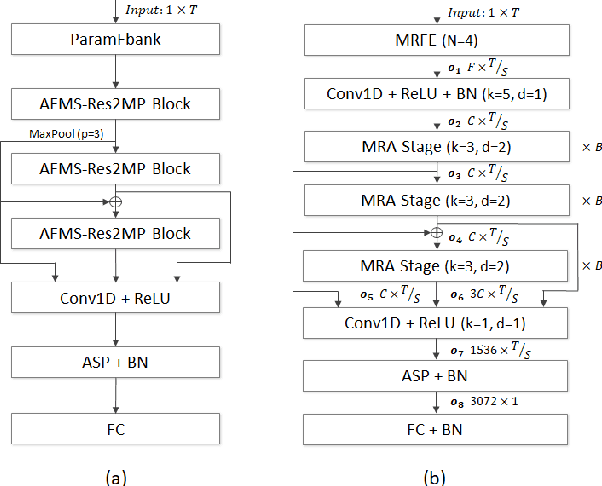

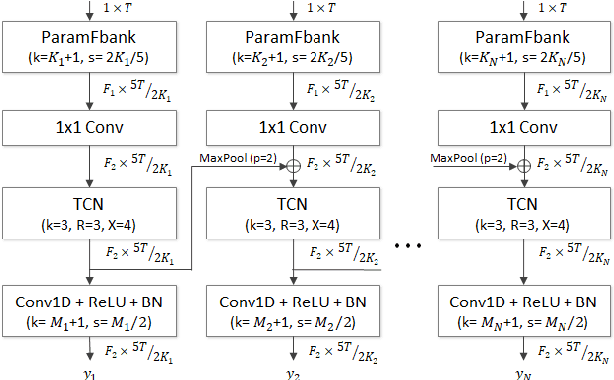

Abstract:In speaker verification systems, the utilization of short utterances presents a persistent challenge, leading to performance degradation primarily due to insufficient phonetic information to characterize the speakers. To overcome this obstacle, we propose a novel structure, MR-RawNet, designed to enhance the robustness of speaker verification systems against variable duration utterances using raw waveforms. The MR-RawNet extracts time-frequency representations from raw waveforms via a multi-resolution feature extractor that optimally adjusts both temporal and spectral resolutions simultaneously. Furthermore, we apply a multi-resolution attention block that focuses on diverse and extensive temporal contexts, ensuring robustness against changes in utterance length. The experimental results, conducted on VoxCeleb1 dataset, demonstrate that the MR-RawNet exhibits superior performance in handling utterances of variable duration compared to other raw waveform-based systems.
NM-FlowGAN: Modeling sRGB Noise with a Hybrid Approach based on Normalizing Flows and Generative Adversarial Networks
Dec 15, 2023



Abstract:Modeling and synthesizing real sRGB noise is crucial for various low-level vision tasks. The distribution of real sRGB noise is highly complex and affected by a multitude of factors, making its accurate modeling extremely challenging. Therefore, recent studies have proposed methods that employ data-driven generative models, such as generative adversarial networks (GAN) and Normalizing Flows. These studies achieve more accurate modeling of sRGB noise compared to traditional noise modeling methods. However, there are performance limitations due to the inherent characteristics of each generative model. To address this issue, we propose NM-FlowGAN, a hybrid approach that exploits the strengths of both GAN and Normalizing Flows. We simultaneously employ a pixel-wise noise modeling network based on Normalizing Flows, and spatial correlation modeling networks based on GAN. In our experiments, our NM-FlowGAN outperforms other baselines on the sRGB noise synthesis task. Moreover, the denoising neural network, trained with synthesized image pairs from our model, also shows superior performance compared to other baselines. Our code is available at: https://github.com/YoungJooHan/NM-FlowGAN
HM-Conformer: A Conformer-based audio deepfake detection system with hierarchical pooling and multi-level classification token aggregation methods
Sep 15, 2023Abstract:Audio deepfake detection (ADD) is the task of detecting spoofing attacks generated by text-to-speech or voice conversion systems. Spoofing evidence, which helps to distinguish between spoofed and bona-fide utterances, might exist either locally or globally in the input features. To capture these, the Conformer, which consists of Transformers and CNN, possesses a suitable structure. However, since the Conformer was designed for sequence-to-sequence tasks, its direct application to ADD tasks may be sub-optimal. To tackle this limitation, we propose HM-Conformer by adopting two components: (1) Hierarchical pooling method progressively reducing the sequence length to eliminate duplicated information (2) Multi-level classification token aggregation method utilizing classification tokens to gather information from different blocks. Owing to these components, HM-Conformer can efficiently detect spoofing evidence by processing various sequence lengths and aggregating them. In experimental results on the ASVspoof 2021 Deepfake dataset, HM-Conformer achieved a 15.71% EER, showing competitive performance compared to recent systems.
Diff-SV: A Unified Hierarchical Framework for Noise-Robust Speaker Verification Using Score-Based Diffusion Probabilistic Models
Sep 14, 2023



Abstract:Background noise considerably reduces the accuracy and reliability of speaker verification (SV) systems. These challenges can be addressed using a speech enhancement system as a front-end module. Recently, diffusion probabilistic models (DPMs) have exhibited remarkable noise-compensation capabilities in the speech enhancement domain. Building on this success, we propose Diff-SV, a noise-robust SV framework that leverages DPM. Diff-SV unifies a DPM-based speech enhancement system with a speaker embedding extractor, and yields a discriminative and noise-tolerable speaker representation through a hierarchical structure. The proposed model was evaluated under both in-domain and out-of-domain noisy conditions using the VoxCeleb1 test set, an external noise source, and the VOiCES corpus. The obtained experimental results demonstrate that Diff-SV achieves state-of-the-art performance, outperforming recently proposed noise-robust SV systems.
PAS: Partial Additive Speech Data Augmentation Method for Noise Robust Speaker Verification
Jul 20, 2023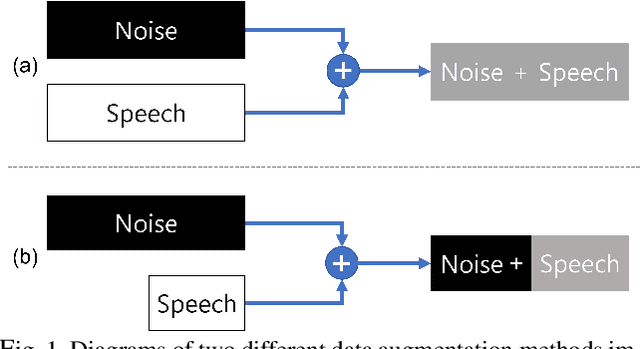
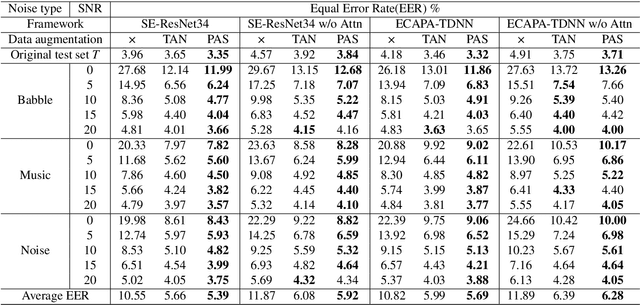
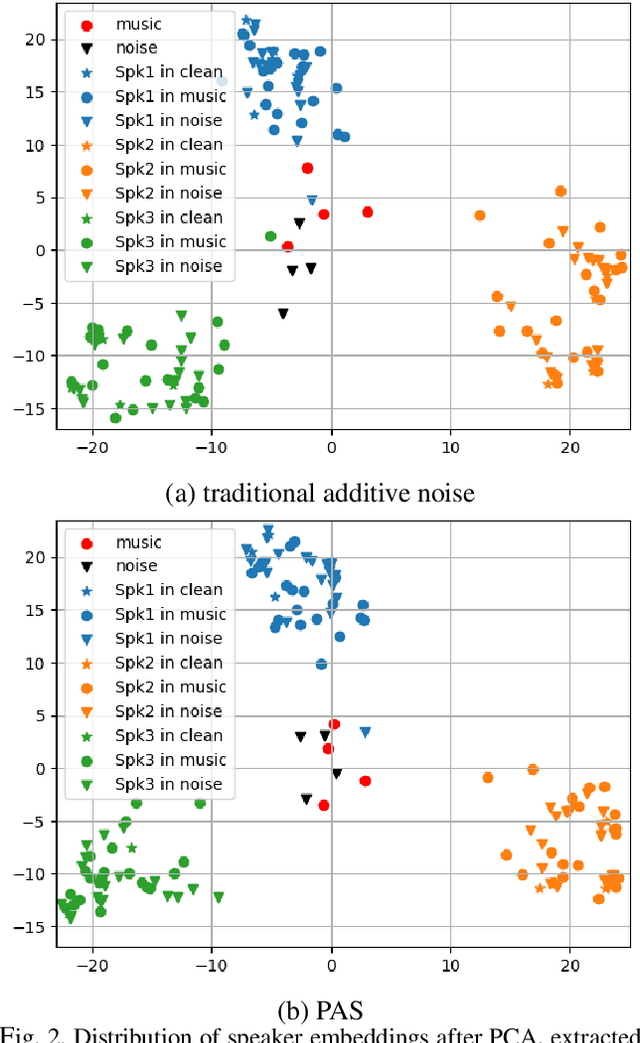
Abstract:Background noise reduces speech intelligibility and quality, making speaker verification (SV) in noisy environments a challenging task. To improve the noise robustness of SV systems, additive noise data augmentation method has been commonly used. In this paper, we propose a new additive noise method, partial additive speech (PAS), which aims to train SV systems to be less affected by noisy environments. The experimental results demonstrate that PAS outperforms traditional additive noise in terms of equal error rates (EER), with relative improvements of 4.64% and 5.01% observed in SE-ResNet34 and ECAPA-TDNN. We also show the effectiveness of proposed method by analyzing attention modules and visualizing speaker embeddings.
One-Step Knowledge Distillation and Fine-Tuning in Using Large Pre-Trained Self-Supervised Learning Models for Speaker Verification
Jun 08, 2023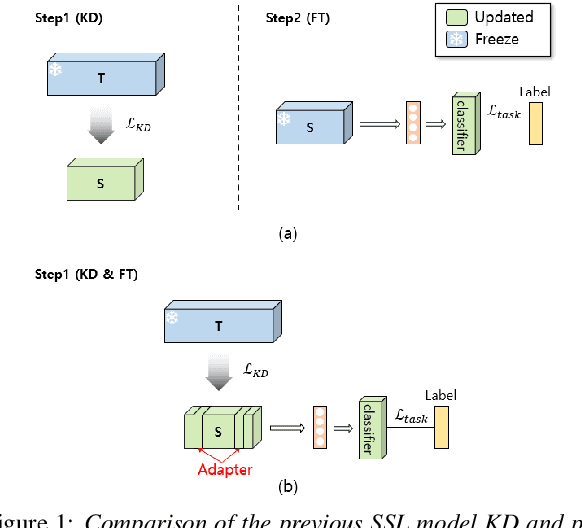

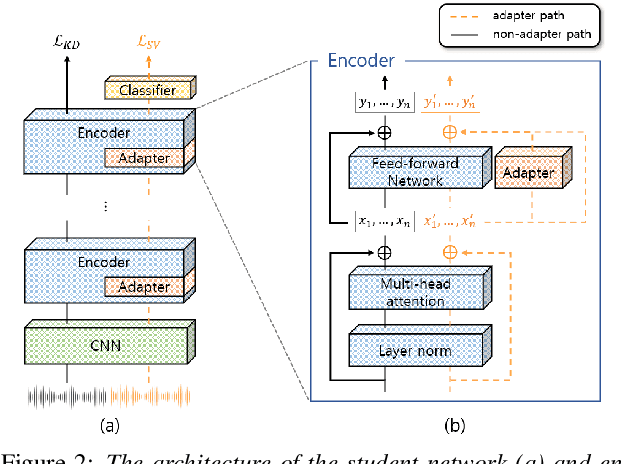

Abstract:The application of speech self-supervised learning (SSL) models has achieved remarkable performance in speaker verification (SV). However, there is a computational cost hurdle in employing them, which makes development and deployment difficult. Several studies have simply compressed SSL models through knowledge distillation (KD) without considering the target task. Consequently, these methods could not extract SV-tailored features. This paper suggests One-Step Knowledge Distillation and Fine-Tuning (OS-KDFT), which incorporates KD and fine-tuning (FT). We optimize a student model for SV during KD training to avert the distillation of inappropriate information for the SV. OS-KDFT could downsize Wav2Vec 2.0 based ECAPA-TDNN size by approximately 76.2%, and reduce the SSL model's inference time by 79% while presenting an EER of 0.98%. The proposed OS-KDFT is validated across VoxCeleb1 and VoxCeleb2 datasets and W2V2 and HuBERT SSL models. Experiments are available on our GitHub.
SS-BSN: Attentive Blind-Spot Network for Self-Supervised Denoising with Nonlocal Self-Similarity
May 17, 2023



Abstract:Recently, numerous studies have been conducted on supervised learning-based image denoising methods. However, these methods rely on large-scale noisy-clean image pairs, which are difficult to obtain in practice. Denoising methods with self-supervised training that can be trained with only noisy images have been proposed to address the limitation. These methods are based on the convolutional neural network (CNN) and have shown promising performance. However, CNN-based methods do not consider using nonlocal self-similarities essential in the traditional method, which can cause performance limitations. This paper presents self-similarity attention (SS-Attention), a novel self-attention module that can capture nonlocal self-similarities to solve the problem. We focus on designing a lightweight self-attention module in a pixel-wise manner, which is nearly impossible to implement using the classic self-attention module due to the quadratically increasing complexity with spatial resolution. Furthermore, we integrate SS-Attention into the blind-spot network called self-similarity-based blind-spot network (SS-BSN). We conduct the experiments on real-world image denoising tasks. The proposed method quantitatively and qualitatively outperforms state-of-the-art methods in self-supervised denoising on the Smartphone Image Denoising Dataset (SIDD) and Darmstadt Noise Dataset (DND) benchmark datasets.
Integrated Parameter-Efficient Tuning for General-Purpose Audio Models
Nov 04, 2022



Abstract:The advent of hyper-scale and general-purpose pre-trained models is shifting the paradigm of building task-specific models for target tasks. In the field of audio research, task-agnostic pre-trained models with high transferability and adaptability have achieved state-of-the-art performances through fine-tuning for downstream tasks. Nevertheless, re-training all the parameters of these massive models entails an enormous amount of time and cost, along with a huge carbon footprint. To overcome these limitations, the present study explores and applies efficient transfer learning methods in the audio domain. We also propose an integrated parameter-efficient tuning (IPET) framework by aggregating the embedding prompt (a prompt-based learning approach), and the adapter (an effective transfer learning method). We demonstrate the efficacy of the proposed framework using two backbone pre-trained audio models with different characteristics: the audio spectrogram transformer and wav2vec 2.0. The proposed IPET framework exhibits remarkable performance compared to fine-tuning method with fewer trainable parameters in four downstream tasks: sound event classification, music genre classification, keyword spotting, and speaker verification. Furthermore, the authors identify and analyze the shortcomings of the IPET framework, providing lessons and research directions for parameter efficient tuning in the audio domain.
Convolution channel separation and frequency sub-bands aggregation for music genre classification
Nov 03, 2022



Abstract:In music, short-term features such as pitch and tempo constitute long-term semantic features such as melody and narrative. A music genre classification (MGC) system should be able to analyze these features. In this research, we propose a novel framework that can extract and aggregate both short- and long-term features hierarchically. Our framework is based on ECAPA-TDNN, where all the layers that extract short-term features are affected by the layers that extract long-term features because of the back-propagation training. To prevent the distortion of short-term features, we devised the convolution channel separation technique that separates short-term features from long-term feature extraction paths. To extract more diverse features from our framework, we incorporated the frequency sub-bands aggregation method, which divides the input spectrogram along frequency bandwidths and processes each segment. We evaluated our framework using the Melon Playlist dataset which is a large-scale dataset containing 600 times more data than GTZAN which is a widely used dataset in MGC studies. As the result, our framework achieved 70.4% accuracy, which was improved by 16.9% compared to a conventional framework.
Extended U-Net for Speaker Verification in Noisy Environments
Jun 27, 2022



Abstract:Background noise is a well-known factor that deteriorates the accuracy and reliability of speaker verification (SV) systems by blurring speech intelligibility. Various studies have used separate pretrained enhancement models as the front-end module of the SV system in noisy environments, and these methods effectively remove noises. However, the denoising process of independent enhancement models not tailored to the SV task can also distort the speaker information included in utterances. We argue that the enhancement network and speaker embedding extractor should be fully jointly trained for SV tasks under noisy conditions to alleviate this issue. Therefore, we proposed a U-Net-based integrated framework that simultaneously optimizes speaker identification and feature enhancement losses. Moreover, we analyzed the structural limitations of using U-Net directly for noise SV tasks and further proposed Extended U-Net to reduce these drawbacks. We evaluated the models on the noise-synthesized VoxCeleb1 test set and VOiCES development set recorded in various noisy scenarios. The experimental results demonstrate that the U-Net-based fully joint training framework is more effective than the baseline, and the extended U-Net exhibited state-of-the-art performance versus the recently proposed compensation systems.
 Add to Chrome
Add to Chrome Add to Firefox
Add to Firefox Add to Edge
Add to Edge